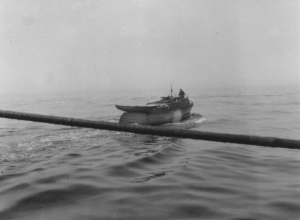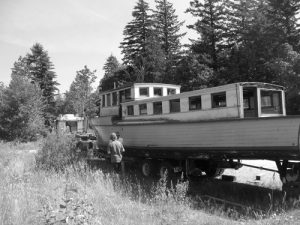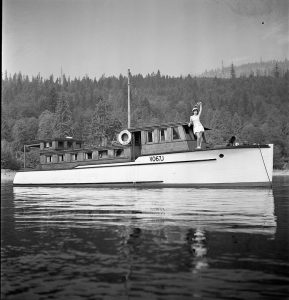
It was only a short time after my rum running book came out that I began being contacted by folks with more tales to share and tell. I was particularly intrigued to hear from Susan Ben–Oliel who revealed that she and her husband were the current owners of Johnny Schnaar’s fast purpose built ‘runner Kitnayakwa.
Susan Ben–Oliel said that “there is an interesting story and one word behind the acquisition of the Kitnayakwa – my husband found it on the Seattle Craigslist! It was initially in bad shape and was partially

submerged when we had it brought up to Canada in July 2009 (on the back of a flatbed truck)” Over time (and much more slowly than they would have hoped) they have been trying to restore it. They later painted the exterior and built a lean–to to cover it and a deck around it. It sits right at the edge of their lake house (on Echo Lake, at Harrison Mills). Susan says “at least close to water if not in it.”
Throughout the U.S. Prohibition years, there were two different ways that Canadian rum runners carried out their operations in southern British Columbia waters. The bulk of the trade involved a variety of Canadian small vessels delivering up liquor orders to American boats. This took place in a generally safe manner within B.C. waters such as Haro Strait which the Victoria Daily Colonist of the day described as filled with small islands serving as “Oases of Scotch in a Sea of Saltwater”. The other method entailed taking on a high level of risk by delivering up booze directly onto Washington State beaches which was otherwise described as ‘jumping the line.’
One mariner who proved particularly adept at this very lucrative undertaking was Johnny Schnaar. After hauling liquor out of Victoria’s Inner Harbour for Fred Kohse in the initial years of the trade, Schnaar soon figured that he’d probably do even better with a boat of his own. Right up until Prohibition finally ended in December 1933, Johnny designed and had built five fast wood hull shore boats. The fourth one built in the boatyard of Tomotaro Yoneda on Chatham Street, Victoria, was the 45 foot 8 inches long Kitnayakwa which was powered by two high speed Lee gas engines capable of delivering 1,036 horsepower to her twin screws, which were good for up to forty knots. What was amazing is that some 91 years after her launching in Victoria in 1928, the Kitnayawka is still with us.

Following the end of the prohibition years in December 1933, the owners of the rum trade’s fleet of boats had to look for other pursuits in order to keep them working or just sell them off. As it happened, a number of fast runners were turned into lovely yachts, one being the Kitnayakwa. Sometime around 1938, Gordon Kilpatrick, who was living out at Point Grey in Vancouver at the time, bought her and she became his family’s yacht “Kitty”. Then when his son married in 1945, the young couple lived aboard her for a year until they could have a house built ashore. Mr. Kilpatrick sold her off sometime in the late ‘40s and many years later she finally ended up in the hands of Susan Ben-Oliel and her husband.